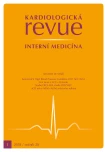Chronic heart failure and palliative care
Authors:
J. Vítovec 1; L. Špinarová 1; J. Špinar 2
Authors‘ workplace:
I. interní kardioangiologická klinika LF MU a FN u sv. Anny v Brně
1; Interní kardiologická klinika LF MU a FN Brno
2
Published in:
Kardiol Rev Int Med 2018, 20(1): 29-32
Overview
Heart failure is an increasingly widespread clinical syndrome in cardiology, which limits life expectancy and has a serious impact on its quality. Since HF treatment improves survival time, the number of patients who develop to the terminal status with this diagnosis increases. Significant symptoms and psychosocial difficulties begin to appear during treatment, which has the task of prolonging life or treating a life-limiting illness. Palliative care involves multiple disciplines to address the difficulties caused by the symptoms of the illness, and related aspects of the patient and family that are perceived as one, because one's sense of well-being affects others.
Key words:
heart failure – palliative care – non-pharmacological treatment
Sources
1. Vorlíček J, Adam Z, Pospíšilová Y a kol. Paliativní medicina. 2. vyd. Praha: Grada 2004.
2. Goodlin SJ, Hauptman PJ, Arnold R et al. Consensus statement: palliative and supportive care in advanced heart failure. J Card Fail 2004; 10(3): 200– 209.
3. Evangelista LS, Dracup K, Doering L et al. Emotional well-being of heart failure patients and their caregivers. J Card Fail 2002; 8(5): 300– 305.
4. Špinar J, Hradec J, Špinarová L et al. Summary of the 2016 ESC Guidelines on the diagnosis and treatment of acute and chronic heart failure. Prepared by the Czech Society of Cardiology. Cor Vasa 2016; 58: 530– 568.
5. Gřiva M. (ed.) Paliativní péče v kardiologii. Praha: Triton 2018: 271.
6. Clark AL. Origin of symptoms in chronic heart failure. Heart 2006; 92(1): 12– 16. doi: 10.1136/ hrt.2005.066886.
7. Friedrich EB, Böhm M. Management of end stage heart failure. Heart 2007; 93(5): 626– 631. doi: 10.1136/ hrt.2006.098814.
8. Chang VT, Hwang SS, Feuerman M. Validation of the Edmonton Symptom Assessment Scale. Cancer 2000; 88(9): 2164– 2171.
9. Opasich C, Gualco A, De Feo S. Physical and emotional symptom burden of patients with end-stage heart failure: what to measure, how and why. J Cardiovasc Med 2008; 9(11): 1104– 1108. doi: 10.2459/ JCM.0b013e32830c1b45.
10. Rector TS, Cohn JN. Assessment of patient outcome with the Minnesota Living with Heart Failure questionnaire: reliability and validity during a randomized, double-blind, placebo-controlled trial of pimobendan. Pimobendan Multicenter Research Group. Am Heart J 1992; 124(4): 1017– 1025.
11. Green CP, Porter CB, Bresnahan DR et al. Development and evaluation of the Kansas City Cardiomyopathy Questionnaire: a new health status measure for heart failure. J Am Coll Cardiol 2000; 35(5): 1245– 1255.
12. Dracup K, Westlake C, Erickson VS et al. Perceived control reduces emotional stress in patients with heart failure. J Heart Lung Transplant 2003; 22(1): 90– 93.
13. Goodlin SJ, Quill TE, Arnold RM. Communication and decision-making about prognosis in heart failure care. J Card Fail 2008; 14: 106– 113. doi: 10.1016/ j.cardfail.2007.10.022.
14. Lee DS, Austin PC, Rouleau JL et al. Predicting mortality among patients hospitalized for heart failure: derivation and validation of a clinical model. JAMA 2003; 290(19): 2581– 2587. doi: 10.1001/ jama.290.19.2581.
15. Levy WC, Mozaffarian D, Linker DT. The Seattle Heart Failure Model: prediction of survival in heart failure. Circulation 2006; 113(11): 1424– 1433. doi: 10.1161/ CIRCULATIONAHA.105.584102.
16. Teuteberg JJ, Lewis EF, Nohria A. Characteristics of patients who die with heart failure and a low ejection fraction in the new millennium. J Card Fail 2006; 12(1): 47– 53. doi: 10.1016/ j.cardfail.2005.08.001.
17. Derfler MC, Jacob M, Wolf RE et al. Mode of death from congestive heart failure: implications for clinical management. Am J Geriatr Cardiol 2004; 13(6): 299– 304.
18. MacIver J, Rao V, Delgado DH et al. Choices: a study of preferences for end-of-lifetreatments in patients with advanced heart failure. J Heart Lung Transplant 2008; 27(9): 1002– 1007. doi: 10.1016/ j.healun.2008.06.002.
19. Lewis EF, Johnson PA, Johnson W et al. Preferences for quality of life or survival expressed by patients with heart failure. J Heart Lung Transplant 2001; 20(9): 1016– 1024.
20. Stevenson LW, Hellkamp AS, Leier CV et al. Changing preferences for survival after hospitalization with advanced heart failure. J Am Coll Cardiol 2008; 52(21): 1702– 1708. doi: 10.1016/ j.jacc.2008.08.028.
21. Hauptman PJ, Havranek P. Integrating palliative care into heart failure care. Arch Intern Med 2005; 165(4): 374– 378. doi: 10.1001/ archinte.165.4.374.
22. Hauptman PJ, Swindle J, Hussain Z et al. Physician attitudes toward end-stage heart failure: a national survey. Am J Med 2008; 121(2): 127– 135. doi: 10.1016/ j.amjmed.2007.08.035.
23. Peura JL, Colvin-Adams M, Francis GS et al. Recommendations for the use of mechanical circulatory support: device strategies and patient selection: a scientific statement from the American Heart Association. Circulation 2012; 126(22): 2648– 2667. doi: 10.1161/ CIR.0b013e3182769a54.
24. Goddlin SJ. Palliative care in congestive heart failure. J Am Coll Cardiol 2009; 54(5): 386– 396. doi: 10.1016/ j.jacc.2009.02.078.
25. Kabelka L. Geriatrická paliativní péče. Praha: Mladá Fronta 2017.
Labels
Angiology Paediatric cardiology Vascular surgery Internal medicine Cardiac surgery CardiologyArticle was published in
Cardiology Review

2018 Issue 1
Most read in this issue
- Overview of echocardiographic parameters in the diagnostics of heart failure with preserved ejection fraction of the left ventricle
- Specifics of diagnostics and treatment in old age
- Heart failure in old age
- Old-age thyroid disease and cardiovascular disorders
